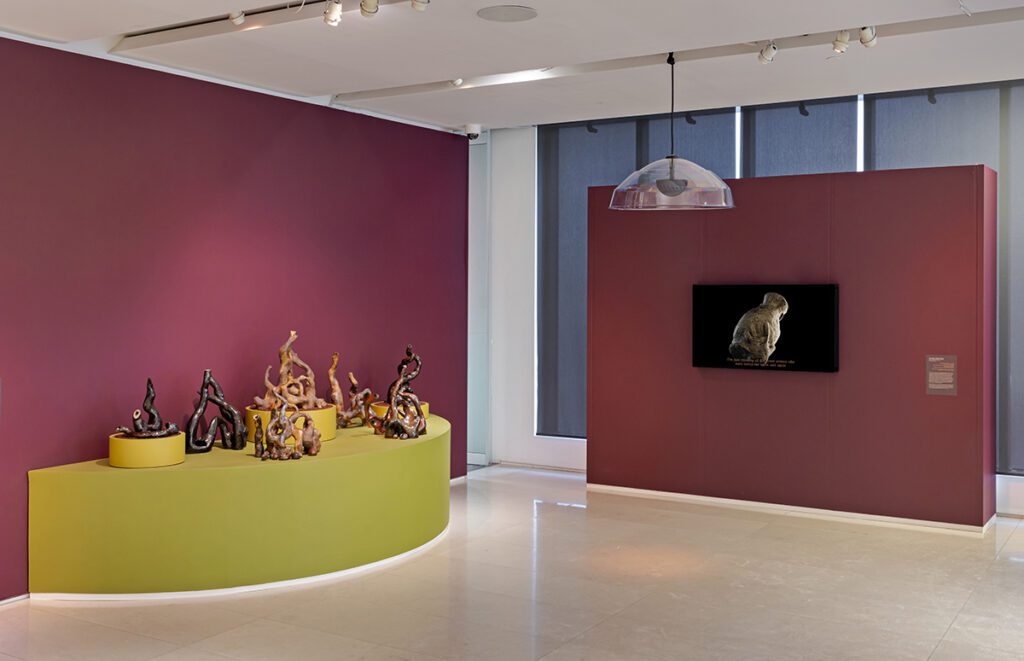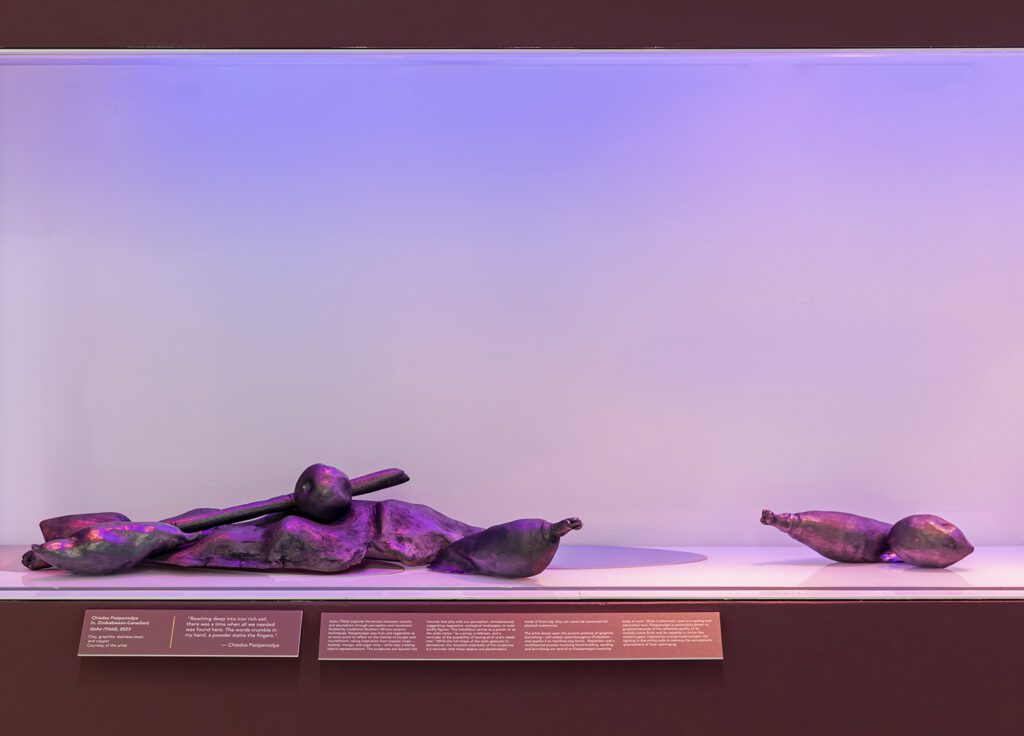Genealogies of Sustenance at the Gardiner Museum
3 February 2025By Ignazio Colt Nicastro

With stained plum walls, soil-filled plinths, and an emanating neon panel, the Gardiner Museum’s lobby became an installation in itself as part of the group exhibition curated by Sarah Edo titled, Genealogies of Sustenance. Viewers’ eyes were immediately drawn to the collection of artworks housed within and outside the museum’s walls, from the soft glowing hue of artist Chiedza Pasipanodya’s handcrafted fruits, the staggering towers of Mallory Lowe Mpoka’s mangrove roots, right through to the anthological video installation by Zainab Aliyu.
As the recipient of last year’s Gardiner Museum Curatorial Fellowship program, Edo traveled to London, UK and Cape Town, South Africa to research various forms of Black material cultures within sculpture-centric exhibitions. Inspired by these practices found during her research, Edo returned to Toronto to curate Genealogies of Sustenance, an echo of another exhibition curated for Whippersnapper Gallery titled, Within and Without, which mediated relations around traditional pottery forms in Southern and Eastern Africa. In this edition, Edo retained the theme of geographical ties to the land to further explore pottery forms within Africa, that pursue themes of sustenance, ancestral and embodied memory, and ecological environments.
One of the first objects that the viewer engages with as they enter the exhibition is a series of hand formed mangoes, baobabs, cacao, and sugar cane, all sheltered within a glass vitrine. The graphite-burnished tones of Pasipanodya’s clay vegetation shone within this long iridescent panel made up of hazing blue, orange, and purple lights. All common fruits in Zimbabwe known for their abundance of nutrients, Goho (Yield), (2023), channeled Pasipanodya’s dialogue around literal forms of sustenance born from the artists’ own genealogical teachings and desire to create a connection to home. Curiously, Pasipanodya molded these fruits from memory to become tangible proxies to bridge themself and audiences back to their home country. In this way, the works are a visual representation of having just enough food to sustain ourselves, but on a deeper level, they are a metaphor for accessing cultural techniques through present day materials.
To emulate the metallic and lustrous texture of these fruits, Pasipanodya utilized the Zimbabwean ceramic technique of graphite burnishing, which involves rubbing graphite against unglazed ceramic after its been fired. As these metallic forms sat nestled together in small groups of three or five, they reflected the sunset hues from the lights placed above them, creating a portal like fusion of colour. This amalgamation of esoteric techniques presented within a shimmering vessel introduced audiences to the notion of Black Quantum Futurism, a philosophical movement and a collaborative interdisciplinary practice developed by Rasheedah Phillips and Camae Ayewa.1 By combining elements of Afrofuturism, quantum physics, and African diasporic traditions, Pasipanodya’s work became a series of talismans that act as portals. However, rather than being an interdimensional force that transports someone from one place to another, Pasipandoya is traversing through time, reaching into the past to reunite with memories of home.
During an artist panel on this exhibition, Pasipanodya explained how Goho (Yield) represented the perfect amount of food to meet our needs, conveying necessity rather than gluttony. As food is often consumed excessively in the Western world, the artist asks: What if we didn’t live in excess? What if we only consumed what was necessary? This rethinking of consumption addresses the excess food waste North America produces and directs audiences to think about the artists’ work through the notion of quantity. Leveraging their genealogical teachings of Zimbabwean graphite burnish and Futurism, Pasipanodya encourages us to consume this cultural tradition and nourish ourselves with this labour.
While Pasipanodya combined their genealogical teachings with elements of Afrofuturism, Zainab Aliyu presented a new media perspective on sustenance by presenting a video installation, incorporating 3-dimensional renderings of black and orange digital vessels paired with a playful soundscape played through a shower speaker. Across this forty-minute film, over thirty digital formed ceramic objects slowly orbited on screen, twisting and turning as an anthology of stories was revealed. This anthology shared tales of Black hopes, dreams, wishes, and intentions, from thirty filmmakers working within African diasporic cinema, providing another form of spiritual fulfilment. Some of the stories talk specifically to personal strife, celebration, or general desires for cultural preservation, but they all engage with this reinvention of ceramic display. From red dust to Black Clay (2023) is an innovative approach to display artworks in a museum dedicated to showcasing clay and ceramics. The video demonstrates how traditions can evolve while being conscious of the limitations of museum collections. It explores various interpretations of pottery in a single channel video rather than across thirty physical forms, allowing for the dissemination of numerous narratives. Aliyu’s work remarks on the space we occupy when sharing stories, transforming the physical act of clay making into a virtual one, allowing others to tell their stories alongside hers.
Both pottery and film can be considered as “vessels” for these expressions, allowing artists to mould and shape stories through their respective mediums. The resulting intergenerational and intermedia exchange via pottery and film within African diasporic cinema is a notable achievement that showcases visual art while simultaneously providing context on its origin.

Situated between these artists is Mallory Lowe Mpoka’s Rhizomatic Placemaking (2023), contrasted against the painted plum walls, which cradled the works away from the sterile white walls of the museum. Atop the brightly painted green semi-circular plinths which sat at staggering heights and held Cameroonian soil, roots of planted mangrove trees erupted in twisting forms into the museum space. The traditional medicinal use of these roots, known as breathing roots, reflects the historical use of the plants as vital sites of refuge and resources for enslaved people escaping during the Atlantic Slave Trade.2 As mangrove swamps were seen as undesirable by European colonizers to Africa, they became sanctuaries to avoid colonial authorities, as they were notable sources of firewood, medicine, and food. While the roots alone do not literally reflect this, the plants as a whole are an interpretation of what sustenance can provide, especially through rest and healing.
While Mpoka is more known for her lens-based and textile practice, this presentation of sculpture is invigorating and thorough, demonstrating the versatility of her practice while embedding the exhibition with more exploratory methods of presenting ceramics. Piles of uncased soil filled with dangling roots directly from Cameroon provided yet another form of bridging audiences to countries and histories far from reach, as if they were living and breathing relics of the past.
This presentation isn’t the first time Mpoka has infused Cameroonian soil within her work,and by reusing the soil in this installation, Mpoka unifies the viewers with the journey of her own history that transcends the political bureaucracy of national borders. The roots that climb out from the Cameroonian soil exist above ground, and, like Mpoka’s practice, the roots are versatile, bending to the environments around them and providing refuge to those tied to African diasporic communities.
Collectively, the three artists reached across time to resurface their own ancestral narratives. They used food and burnishing techniques as a form of time travel, engaged with contemporary new media to archive intergenerational mediations, and infused international soils to establish a direct connection to home. Sarah Edo’s curatorial framework around African pottery forms redefined sustenance through the artists genealogies, and created space for these artists to present new forms of knowledge transfer, ancestral memory, and ecological representations.
- For more information on Black Quantum Futurism (BQF), see here: https://www.blackquantumfuturism.com/about.
- Judith Carney, “‘The mangrove preserves life’: Habitat of African survival in the Atlantic world,” Geographical Review, 107 no. 3, (2017), https://onlinelibrary.wiley.com/doi/abs/10.1111/j.1931-0846.2016.12205.x.
Genealogies of Sustenance was curated by Sarah Edo and ran from January 19 – May 12, 2024 at the Gardiner Museum in Toronto, ON.
Feature Image: Goho (Yield), 2023-24 by Chiedza Pasipanodya. Photo by Toni Hafkenscheid courtesy of Sarah Edo.



